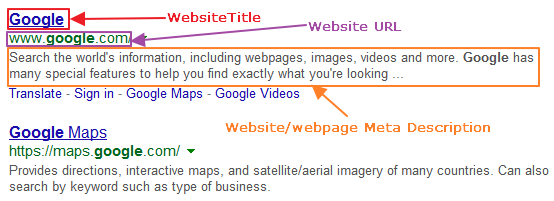On-Page SEO
On-Page SEO is the practice of optimizing each and every web page for the purpose to rank higher and earn more relevant traffic in the Search Engine Results Pages (SERPs).
On-Page SEO is all the things that we do on the website to boost ranking.
According to different expert, there are many On-Page SEO techniques that you can apply to your website and boost your SEO:
- Meta Title: Title is the most important on-page factor for a search engine. It gives the accurate description of the page content and the title is what the users will see in the search engine for both organic and paid ads. Google looks at the title of your page and the length of the title should be between 65 to 70 characters. Coding for the title looks like: <title>SEO On-Page</title>
- Meta Description: Meta Description tag is the website summary and it is the place where users will find what your site is all about. Good Meta Description contains the keywords that help in increasing CTR (Click-through-Rate) because Search Engine read the meta description to determine the page’s topic. Length of the meta description between 150 to 160 characters including spaces.
- URL: URL is the website strongest summary of the web page. URL should contain the keywords and describe closely what the page is about. The URL prefix provides the details of domain name and suffix provide the summary of the page. URL helps in increasing CTR.

- Keyword: Keywords is the word or phrase that describes the content of the web page in Search engine. Keyword helps in the ranking of the website because keyword makes it possible for people to find your site via search engine. Keywords should be present in all important factors like in headings, subheadings, meta-title, ,eta description, title and in the starting paragraph. It improves the relevancy of the content and helps in better targeting.
- Heading tag: Web Pages include multiple heading tags, from H1 to H6. H1 is the most important heading in Google eyes. Google identify easily the title with an H1. The web page includes H2, H3 or H4 in multiple as subheading and contain only one H1 tag as the keyword which we are targeting.

- Image Optimization: Images also help to boost your ranking. Images need to add alt text, caption, and description, this will help the search engine to understand the image. Without alt text of the images, Google cannot read images.
- Bold and Italic: Bold and Italic is a very useful ranking factor of the web page in the search engine. Bold and Italic can make your web pages to read easily. It make content attractive and differentiate important points.
- Unique Content: Content is the backbone of your website and its ranking in the search engine results. Unique content will consistently rank higher in the search engine. If a website has a Unique or relevant content, visitors can trust you and more likely they want to do business with you.
- Navigation in the page: Navigation in the page might contain a logo, text link, an image in a short description. Navigation helps to the visitors, to go from one page to another page easily or from one post to another post.
- Anchor Text: Anchor Text is a visible and clickable text in a hyperlink when linking to another document or location on the web. It is usually in blue and underlined text. It is relevant for both internal and external link. Anchor text plays a significant role in SEO ranking factor. <a href=”http://www.example.com”>what is Anchor Text</a>

- Keyword Proximity: Keyword proximity refers to how keywords are close together with another or to another element on the website. Example: If a keyword is Digital Marketing Institute in Gurgaon
- Close Proximity: Best Digital Marketing Institute in Gurgaon
- Far Proximity: Which is the best Digital Marketing Institute in Gurgaon
- Keyword Prominence: Keyword should be visually eye-catching in the page header, opening paragraph or start of the content. If the keyword present in the first paragraph it will be beneficial for the SEO.
- Keyword Density: Keyword Density is the percentage of time a keyword appears on a given web page compared to the total number of words on the page. Keyword Density should be between 1-2% to avoid keyword stuffing when your article length is around 1000 to 2ooo words.
- LSI (Latent Semantic Indexing): LSI helps search engine identify related keywords and synonyms to deliver better search result and it is the easier way to find the answer to their search and generation more traffic on the website.
- Rich media content Creation: Rich media is a powerful content tool to promote your web presence, build an audience and generate business. Rich media includes features like infographics, slides, pdf, and video to interact and engage.

